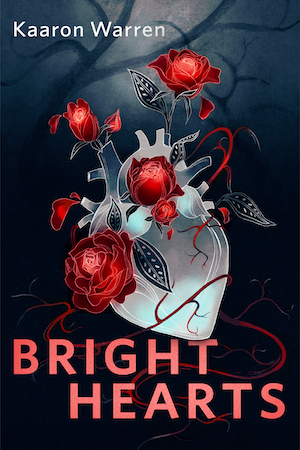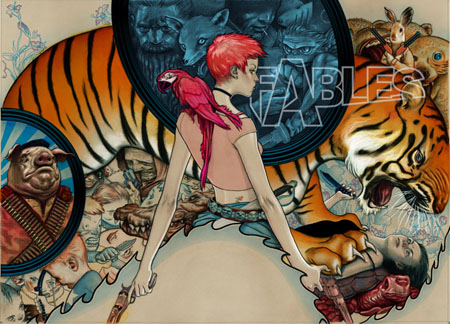And you know the sun’s settin’ fast,
And just like they say, nothing good ever lasts.
Well, go on now and kiss it goodbye,
But hold on to your lover,
’Cause your heart’s bound to die.
—“Our Town,” Iris DeMent
A quick Google search on the word “fable” yields the following pithy definitions:
- A short moral story (often with animal characters)
- Legend: a story about mythical or supernatural beings or events
- A fable is a succinct story, in prose or verse, that features animals, plants, inanimate objects, or forces of nature which are anthropomorphized (given human qualities), and that illustrates a moral lesson (a “moral”), which may at the end be expressed explicitly in a pithy maxim.
Bill Willingham’s Fables is an ongoing monthly comic book that meets all of those criteria in its storytelling. But the most important thing I want to tell you about Fables is that it always contains really good storytelling and artwork. Once you start in on it, if you’re like me, you won’t want to miss a single issue. The book has been appearing since 2002, but I didn’t pick up on it until several years ago.
By now, most of the run has been collected into a series of softcover and hardcover graphic novels. After retroactively hunting down and gobbling up every single issue, it’s my considered opinion that in the entire eight years of its existence, there’s really never been a dull or bad issue of Fables. The series has picked up over a dozen Eisner awards. The twelfth collected volume, The Dark Ages, was a 2010 Hugo nominee. But if you’re new to the series, I wouldn’t recommend that you start there. It’s all good; but I think your enjoyment of the Fables experience will be significantly enhanced if you at least sample the early volumes before plunging into the later ones.
The very first issue of Fables (included in Volume 1: Legends in Exile), narrates a police procedural that takes place on the Upper West Side of New York City. In “Chapter One: Old Tales Revisited,” we meet Snow White, the deputy mayor of Fabletown, and Bigby Wolf, Fabletown’s sheriff. We see Jack (of beanstalk-climbing fame) rush into Bigby’s office to announce that Rose Red (Snow White’s feisty, less famous sister) has gone missing. Bigby informs Snow that foul play is suspected.
The cigar-smoking Bigby, in human form, is slightly reminiscent of a well-known, beloved Marvel character. Notwithstanding that, he is the big bad wolf of Three Little Pigs and Red Riding Hood fame, now reformed under the terms of the Fabletown Compact. Fabletown is a community-in-exile for refugees from the Fable Homeworlds (which have been occupied and oppressed by a powerful, mysterious Adversary). Refugee Fables who can pass for “mundie,” or mundane, humans are permitted to live in the blocks off Bullfinch Street in NYC. Giants, dwarves, talking animals, and other non-human Fable refugees are settled on “The Farm” located in upper New York state. All Fables are required to sign the Compact before joining the community-in-exile. The Compact grants amnesty to signatories for all crimes committed in the Homelands (children sacrificed to demon gods or baked in ovens, vicious magic curses, treacherous murders, pirate plunder, etc.). In exchange, signatories pledge their good behavior in the New World of Exile on pain of death.
Legends in Exile, the first story arc in the series, comprises Fables issues #1 through #6. In it, we see the gradual entanglement of Snow White, the tough-minded, beautiful Deputy Mayor, and Bigby Wolf, the gruff, cynical, outlaw-turned-lawman. Snow and Bigby interview various colorful suspects who might be linked to Rose Red’s disappearance. Bluebeard is a former nobleman and rich, having smuggled his fortune out of the Homelands. He reveals an acerbic, aggressively ambitious personality in conducting fencing lessons with Cinderella. (Cindy will figure largely in future issues of Fables as a covert SWAT operative, and she eventually earns her own spinoff series.)
Cindy and Snow (along with Briar Rose) have all been married to and divorced from Prince Charming, who, at this point in the series, is an attractive but self-absorbed ladies’ man. Charming is newly arrived in Fabletown as a refugee from his conquered Princedom in the Homelands. The first thing he does in New York is pick up a “mundie” waitress, tell her that he’s broke, and move into her apartment. (Once a year, Snow White, Cinderella, and Briar Rose meet for dinner—specifically for the purpose of discussing and dishing on their ex and commiserating on their respective marriage experiences with him.) Touches like this are part of the basic charm of Fables. The emotional spectrum in the stories runs a gamut that transcends the expectations of any particular genre. A straight detective story set in New York City, suddenly features flashbacks to tales of high sorcery and adventure in other worlds. Trolls, werewolves, and flying monkeys are all regular characters. (Bufkin, the chief of the Winged Monkeys from The Wizard of Oz is the archivist of Fabletown’s collection of magic implements from the Homeworlds.)
Bigby, after spending increasing amounts of time with the Deputy Mayor in their investigation, decides to invite her to the Fabletown Remembrance Day Dance. Snow asks whether this is also part of the investigation or whether Bigby is attempting to display romantic interest in her. Bigby attempts a non-commital response. With the aid of Colin, one of the Three Little Pigs who has smuggled himself from the Farm down to Fabletown, Bigby has solved the mystery. The revelatory denouement, with all relevant characters present, will occur at the Remembrance Day Dance. (In Fabletown, Remembrance Day is a Passover-like holiday recognizing all that has been lost in the Adversary’s conquest of the Fable Homeworlds. It’s also a day of promise—that someday the Fable Homeworlds will be retaken from the Adversary.)
As good as this first volume of Fables is, it shows just a small slice of the power of the entire series.If you’re new to the Fables Universe and want to get a spoiler-free look at the power and potential waiting for you, then you should probably track down a copy of the gorgeously-illustrated, coffee table prequel called 1001 Nights of Snowfall.
This original hardcover collection is set in the early days of Fabletown, long before the Fables series began. Traveling in Arabia as an ambassador from the exiled Fables community, Snow White is captured by the local sultan who wants to marry and then kill her. But the clever Snow attempts to charm the sultan instead by playing Scheherazade, telling him fantastic stories for a total of 1,001 nights.
I love this book. Did I mention that it’s gorgeously illustrated? The stories that Snow White tells the Sultan are the back stories or origin stories of most of the prominent characters who will figure in subsequent Fables story arcs. You’ll see John Bolton surpass himself in rendering the tale of Snow White and Prince Charming. You’ll learn how Bigby became The Big Bad Wolf, read the heart-breaking story of the Frog Prince (known as “Flycatcher” in his Fabletown incarnation), and learn how Snow White and Rose Red rescued the evil Witch who became Fabletown’s Grey Ally, Frau Totenkinder.
For people who just can’t get into sequential panels and word balloons, Bill Willingham has written a standalone novel that takes place in the Fables universe. The novel, Peter & Max, contains a good introduction to the Fables universe, and does not require that you be familiar with any of the other comic book stories in the series. You can see for yourself how good Peter & Max is by checking out the sample of Chapter 1, online. (You might also want to check out the new trade edition, due to be released in a few weeks, or the audio book version, beautifully narrated by Wil Wheaton.)
Big things are afoot in the Fables Universe! As you read this, the 100th issue of Fables has debuted on your local comic book store. It’s a giant issue, featuring the conclusion to the currently-running Fables story arc, a foldout board game, and a surprise wrinkle: author Bill Willingham and regular artist Mark Buckingham switching places for one story—with Buckingham doing the writing and Willingham doing the illustrations. If you’re already a regular Fables reader, you know that the Fables stories and artwork just get better and more addictively exciting as the series progresses over its eight-year run. I’m attempting to keep this introduction to the series spoiler-free, so I won’t get into the details of where the series goes after the beginning points discussed in this post.
I envy you, if you’re not ready for the 100th issue of Fables, yet. You’ve got hours and hours of reading pleasure ahead of you, catching up on the Greatest Comic Book Story Ever Told (since 2002, anyway). So you tell me: should future posts in this series follow the “re-read” format—where we can more freely discuss characters and their fates up and down the line? Or, if most of you reading this are just discovering the series, should I continue it in a relatively spoiler-free introductory format?
Lenny Bailes is a longtime science fiction fan, who helps put on small science fiction literary conventions and even still publishes a fanzine. IT specialist by day and college instructor by night, he desperately tries to find time for other reading, writing, and music making.










